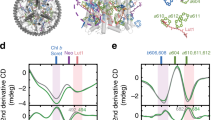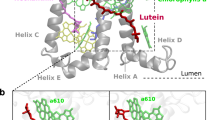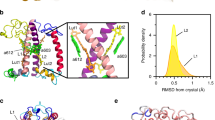Abstract
Under conditions of excess sunlight the efficient light-harvesting antenna1 found in the chloroplast membranes of plants is rapidly and reversibly switched into a photoprotected quenched state in which potentially harmful absorbed energy is dissipated as heat2,3, a process measured as the non-photochemical quenching of chlorophyll fluorescence or qE. Although the biological significance of qE is established4,5,6, the molecular mechanisms involved are not7,8,9. LHCII, the main light-harvesting complex, has an inbuilt capability to undergo transformation into a dissipative state by conformational change10 and it was suggested that this provides a molecular basis for qE, but it is not known if such events occur in vivo or how energy is dissipated in this state. The transition into the dissipative state is associated with a twist in the configuration of the LHCII-bound carotenoid neoxanthin, identified using resonance Raman spectroscopy11. Applying this technique to study isolated chloroplasts and whole leaves, we show here that the same change in neoxanthin configuration occurs in vivo, to an extent consistent with the magnitude of energy dissipation. Femtosecond transient absorption spectroscopy12, performed on purified LHCII in the dissipative state, shows that energy is transferred from chlorophyll a to a low-lying carotenoid excited state, identified as one of the two luteins (lutein 1) in LHCII. Hence, it is experimentally demonstrated that a change in conformation of LHCII occurs in vivo, which opens a channel for energy dissipation by transfer to a bound carotenoid. We suggest that this is the principal mechanism of photoprotection.
This is a preview of subscription content, access via your institution
Access options
Subscribe to this journal
Receive 51 print issues and online access
$199.00 per year
only $3.90 per issue
Buy this article
- Purchase on Springer Link
- Instant access to full article PDF
Prices may be subject to local taxes which are calculated during checkout



Similar content being viewed by others
References
van Grondelle, R. et al. Energy transfer and trapping in photosynthesis. Biochim. Biophys. Acta 1187, 1–65 (1994)
Horton, P., Ruban, A. V. & Walters, R. G. Regulation of light harvesting in green plants. Annu. Rev. Plant Physiol. Plant Mol. Biol. 47, 655–684 (1996)
Niyogi, K. K. Photoprotection revisited. Annu. Rev. Plant Physiol. Plant Mol. Biol. 50, 333–359 (1999)
Demmig-Adams, B. & Adams, W. W. Antioxidants in photosynthesis and human nutrition. Science 298, 2149–2153 (2002)
Horton, P. & Ruban, A. V. Molecular design of the photosystem II light harvesting antenna: photosynthesis and photoprotection. J. Exp. Bot. 56, 365–373 (2005)
Külheim, C., Ågren, J. & Jansson, S. Rapid regulation of light harvesting and plant fitness in the field. Science 297, 91–93 (2002)
Holt, N. E. et al. Carotenoid cation formation and the regulation of photosynthetic light harvesting. Science 307, 433–436 (2005)
Standfuss, J. et al. Mechanisms of photoprotection and nonphotochemical quenching in pea light-harvesting complex at 2.5 Å resolution. EMBO J. 24, 919–928 (2005)
Horton, P., Wentworth, M. & Ruban, A. V. Control of the light harvesting function of chloroplast membranes: the LHCII-aggregation model for non-photochemical quenching. FEBS Lett. 579, 4201–4206 (2005)
Pascal, A. A. et al. Molecular basis of photoprotection and control of photosynthetic light-harvesting. Nature 436, 134–137 (2005)
Robert, B. et al. Insights into the molecular dynamics of the plant light harvesting proteins in vivo . Trends Plant Sci. 9, 385–390 (2004)
van Stokkum, I. H. M., Larsen, D. S. & van Grondelle, R. Global and target analysis of time-resolved spectra. Biochim. Biophys. Acta 1657, 82–104 (2004)
Bassi, R., Pineau, B., Dainese, P. & Marquardt, J. Carotenoid-binding proteins of photosystem II. Eur. J. Biochem. 212, 297–303 (1993)
Ruban, A. V., Pascal, A. A. & Robert, B. Xanthophylls of the major photosynthetic light-harvesting complex of plants: identification, conformation and dynamics. FEBS Lett. 477, 181–185 (2000)
Li, X. P. et al. A pigment-binding protein essential for regulation of photosynthetic light harvesting. Nature 403, 391–395 (2000)
Li, X. P. et al. PsbS-dependent enhancement of feedback de-excitation protects photosystem II from photoinhibition. Proc. Natl Acad. Sci. USA 99, 15222–15227 (2002)
Frank, H. A. et al. Mechanism of nonphotochemical quenching in green plants: Energies of the lowest excited singlet states of violaxanthin and zeaxanthin. Biochemistry 39, 2831–2837 (2000)
Ma, Y. Z. et al. Evidence for direct carotenoid involvement in the regulation of photosynthetic light harvesting. Proc. Natl Acad. Sci. USA 100, 4377–4382 (2003)
Berera, R. et al. A simple artificial light-harvesting dyad as a model for excess energy dissipation in oxygenic photosynthesis. Proc. Natl Acad. Sci. USA 103, 5343–5348 (2006)
Lampoura, S. S. et al. Aggregation of LHCII leads to a redistribution of the triplets over the central xanthophylls in LHCII. Biochemistry 41, 9139–9144 (2002)
Liu, Z. et al. Crystal structure of spinach major light-harvesting complex at 2.72 Å resolution. Nature 428, 287–292 (2004)
van Grondelle, R. & Novoderezhkin, V. I. Energy transfer in photosynthesis: experimental insights and quantitative models. Phys. Chem. Chem. Phys. 8, 793–807 (2006)
Moya, I. et al. Time-resolved fluorescence analysis of the photosystem II antenna proteins in detergent micelles and liposomes. Biochemistry 40, 12552–12561 (2001)
Morosinotto, T., Baronio, R. & Bassi, R. Dynamics of chromophore binding to Lhc proteins in vivo and in vitro during operation of the xanthophyll cycle. J. Biol. Chem. 277, 36913–36920 (2002)
Wentworth, M., Ruban, A. V. & Horton, P. Thermodynamic investigation into the mechanism of the chlorophyll fluorescence quenching in isolated photosystem II light harvesting complexes. J. Biol. Chem. 278, 21845–21850 (2003)
Yan, H. et al. Two lutein molecules in LHCII have different configurations and functions: insights into the molecular mechanism of thermal dissipation in plants. Biochem. Biophys. Res. Commun. 355, 457–463 (2007)
Demmig-Adams, B. & Adams, W. W. Photoprotection in an ecological context: the remarkable complexity of thermal energy dissipation. New Phytol. 172, 11–21 (2006)
Tang, Y. et al. Heat stress induces aggregation of the light harvesting complex of photosystem II in spinach plants. Plant Physiol. 143, 629–638 (2007)
Ruban, A. V. et al. Determination of the stoichiometry and strength of binding of xanthophylls to the photosystem II light harvesting complexes. J. Biol. Chem. 274, 10458–10465 (1999)
Crouchman, S., Ruban, A. V. & Horton, P. PsbS enhances nonphotochemical fluorescence quenching in the absence of zeaxanthin. FEBS Lett. 580, 2053–2058 (2006)
Acknowledgements
This work was supported by grants from: UK Biotechnology and Biological Sciences Research Council (P.H., A.V.R.); the Netherlands Organization for Scientific Research via the Foundation of Earth and Life Sciences (R.v.G., H.v.A., J.T.M.K., R.B.) and a VIDI Fellowship (J.T.M.K); Laserlab Europe; ANR (program caroprotect) (A.A.P., B.R.); and the INTRO2 EU FP6 Marie Curie Research Training Network. We thank K. K. Niyogi for the gift of seeds of the L17 Arabidopsis line.
Author information
Authors and Affiliations
Corresponding authors
Supplementary information
Supplementary Information
This file contains Supplementary Figures 1-6 with Legends and Table 1. The file describes additional supportive data. Firstly, Raman spectra used to determine the contribution of the neoxanthin signal to the in vivo spectra, and the spectra obtained for various LHCII sample in different quenching states. Secondly, further transient absorption traces are displayed, including those recorded in the IR region, and those obtained for LHCII sample at an intermediate quenching state. A more complete description of the model used to fit the absorption data is described, along with a table of all rate constants. (PDF 553 kb)
Rights and permissions
About this article
Cite this article
Ruban, A., Berera, R., Ilioaia, C. et al. Identification of a mechanism of photoprotective energy dissipation in higher plants. Nature 450, 575–578 (2007). https://doi.org/10.1038/nature06262
Received:
Accepted:
Issue Date:
DOI: https://doi.org/10.1038/nature06262
This article is cited by
-
Excitation transfer and quenching in photosystem II, enlightened by carotenoid triplet state in leaves
Photosynthesis Research (2024)
-
Ultrafast excited-state dynamics of Luteins in the major light-harvesting complex LHCII
Photochemical & Photobiological Sciences (2024)
-
Cryo-EM structures of LHCII in photo-active and photo-protecting states reveal allosteric regulation of light harvesting and excess energy dissipation
Nature Plants (2023)
-
Recent progress in atomistic modeling of light-harvesting complexes: a mini review
Photosynthesis Research (2023)
-
A perspective on the major light-harvesting complex dynamics under the effect of pH, salts, and the photoprotective PsbS protein
Photosynthesis Research (2023)
Comments
By submitting a comment you agree to abide by our Terms and Community Guidelines. If you find something abusive or that does not comply with our terms or guidelines please flag it as inappropriate.



